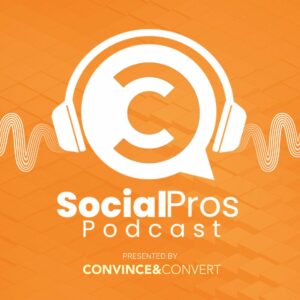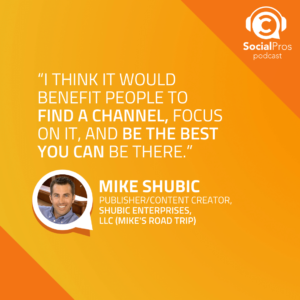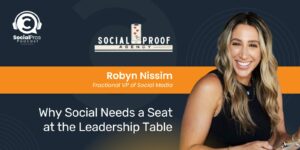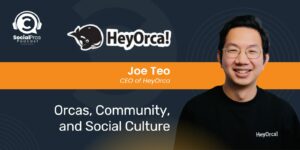Hosted By
About Social Pros Podcast:
Social Pros is one of the longest-running marketing podcasts in existence (10 YEARS and counting), and was recently recognized as the #1 Audio/Podcast Series by the Content Marketing Awards.
Our purpose? Making sure that we speak to real people doing real work in social media.
Listeners get inside stories and behind-the-scenes secrets about how teams at companies like Google, Reddit, Glossier, Zillow, Lyft, Marvel, and dozens more, staff, operate, and measure their social media programs. With 600+ episodes, the Social Pros Podcast brings the humanity of social media to the forefront, while providing incredibly useful marketing strategies that listeners can immediately implement.
Follow Social Pros on LinkedIn.
To inquire about becoming a guest or show sponsor, please email our Executive Producer, Leanna Pham, at leanna@convinceandconvert.com.
Apple Podcast Reviews:
The Social Pros podcast has quickly become a favorite in my feed! I'm consistently impressed by the engaging conversations, insightful content, and actionable ideas. I truly learn something every time I listen!
@Arlie KThis is absolutely an awesome listen for anyone in communications or social media!!
@Will31CThis podcast has become one of my staple weekly podcasts for learning about marketing! Love the conversations that they have and it's always enjoyable and educational!
@Simonstone95Love the podcast - informative, in depth and spot on for any business size.
@MissTriathlon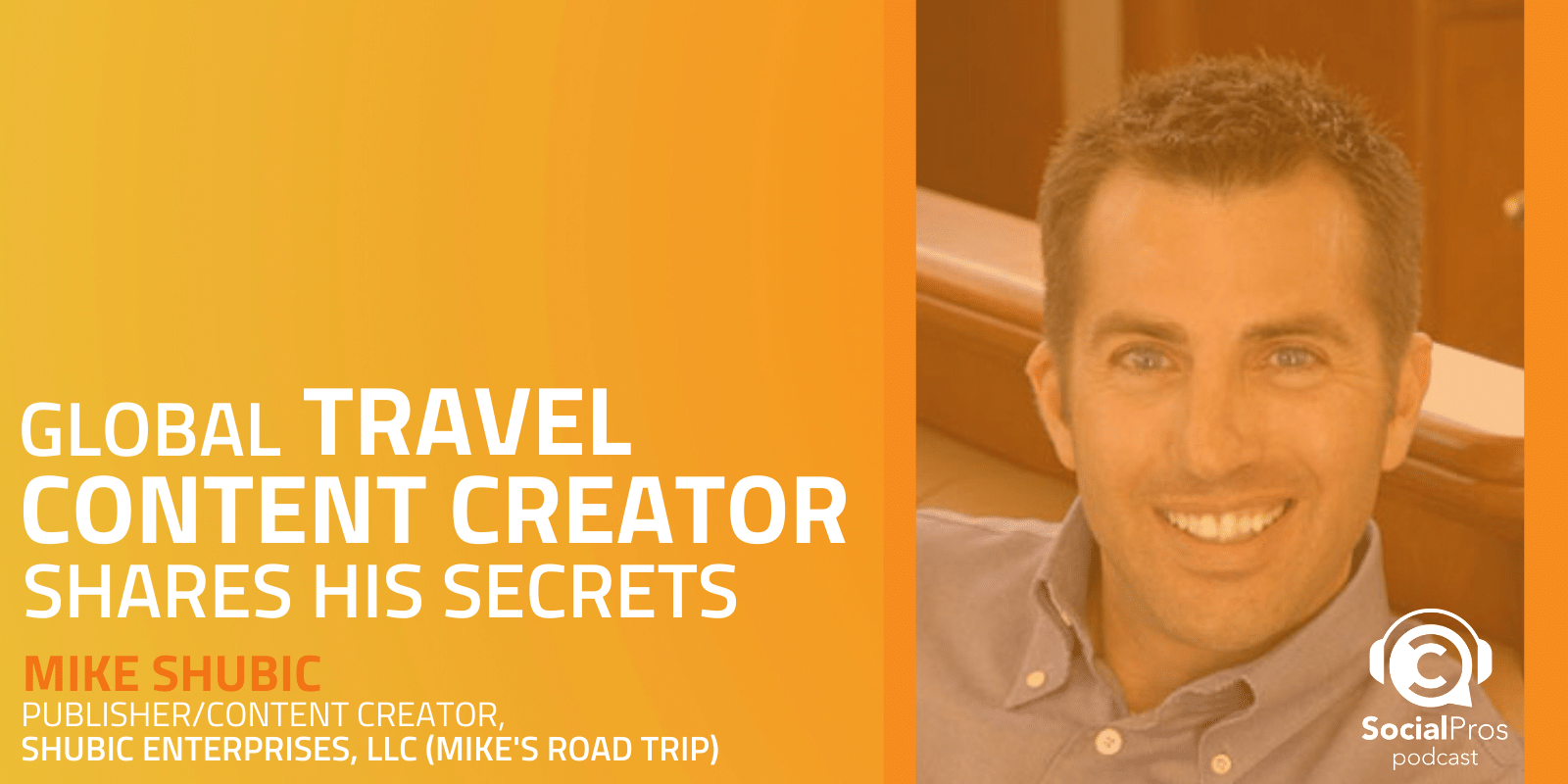
Mike Shubic, video producer, travel writer, and publisher of Mike’s Road Trip, joins the Social Pros podcast to discuss some of the tactics that have helped him get ahead in the travel content creation game.
Creating content that translates across borders
How do you carve a niche for yourself in an industry saturated with travel bloggers, influencers, and enthusiasts?
While there’s no A+B=C type formula for success, Mike Shubic, video producer, travel writer, and publisher of Mike’s Road Trip, joins this episode of Social Pros to share some tips and pointers.
It takes a lot more than high-quality photos and a knack for words to make it in the travel content creation space. Mike highlights this as he shares what he calls the Holy Grail of content creation. He also explains why he thinks it’s best to stick to one or two platforms when creating content.
Mike delves into the unglamorous realities of being a travel content creator and explains what it takes to create a distinct and robust brand in that space.
In This Episode:
- 3:36 – Mike gives a little background on who he is and what he does
- 5:21 – The benefit of travel conferences
- 9:25 – Mike explains the realities of being a travel content creator
- 10:56 – The Holy Grail of content creation
- 11:53 – The benefits of focusing on one social media channel
- 12:50 – How Mike presents his footage on different platforms
- 14:17 – Video quality vs social media algorithms
- 15:27 – Different platforms to help get your content out there
- 17:52 – The core essence of being a travel content creator
- 18:41 – What Mike’s creative process looks like
- 22:25 – How much lead time Mike needs before a job
- 23:59 – Recent trends Mike has noticed in the travel and tourism industry
- 26:27 – How social media affects the way destinations present themselves
- 28:07 – How the tourism industry has grown rapidly
- 30:56 – How to create a distinct and robust travel brand
- 32:24 – Mike’s tip for anyone looking to become a social pro?
Quotes From This Episode:
Instagram has really given a false reality of what it takes to be a content creator out there. It goes beyond taking good quality photos Click To Tweet
“I think travel is so amazing in so many ways, but one of the major benefits is that it’s been my greatest educator.” @MikesRoadTrip
“Brand banners, color schemes, and fonts may seem rudimentary, but they really help brands become recognizable across all platforms.” @MikesRoadTrip
Resources:
Episode Transcript
transcript was exported on May 13, 2022 – view latest version here.
Shubic:
content that is helpful, never expires. And so if you can find a niche that where you can be helpful to people, you can absolutely thrive on YouTube.
Baer:
tell you what, Anna Hrach. I think our guest this week absolutely nailed it there. It doesn’t matter what channel you’re creating content for, or even under what circumstances you are creating content for. If that content is helpful, if it actually assists somebody in knowing more or making better decisions, there will be a market for it. And our guest this week on social pros, Mike Shubic, who’s the proprietor of Mike’s road trip is evidence of that philosophy in action. Mike has been a travel writer, a travel blogger, a travel video creator and a content creator in the travel and tourism space now for well over, I think, a decade and a half. And in this episode, we talk a lot about kind of how that business works. And what separates somebody from Mike from some of those pretenders out there?
Hrach:
it was a great conversation. And, you know, obviously to all of us listening and, and tuning in, it seems like creating helpful content is obviously the golden rule of social content creation. But sometimes as we’ll explore in this, we kind of, you know, lose a little side of that. Having personally researched some recent vacation destinations I can tell you that not all content out there is helpful. So, but Mike has some great tips on how to become more Instagrammable and catch people’s eyes and some trends that are happening. It’s just a great, great show.
Baer:
It’s nice to have somebody on social pros who was really not only making content every single day for their own brand, but has been doing it for so long has kind of seen the full evolution of this industry. And we talk about that a lot in this week’s episode of social pros. Don’t forget if you haven’t had a chance to download our 500th episode commemorative guide, we would love for you to do that. We talk a look at all the episodes we’ve ever recorded here on the show interviewed some of our guests who have been on the show multiple times, pulled together trends, things that have changed in social over the last decade or so. It’s a lot of fun go to Bitly slash social pros, 500 to download it for yourself at no cost B I T dot L Y slash social pros 5 0 0 I’m Jay Baer from convince a convert she’s Anna Hrach from convince and convert. Here we are in the episode of social pros this week, Mike Shubic from Mike’s road trip
Baer:
week on social pros. I am so excited to have as our guest, a long time friend, somebody that I literally grew up with as a business professional from my old stomping grounds in Phoenix, Mike Shubic is a proprietor of Mike’s road trip. And I gotta tell you, his story is incredible because I remember years and years and years and years ago, he said, I’m just gonna make content about travel. And I’m like, cool. How are you gonna get paid for that? And here we are, he has figured it out. Ladies and gentlemen, Mike Shubic, welcome to social pros.
Shubic:
thank you so much, Jay. It’s a pleasure to be here.
Baer:
have literally watched this career of yours unfold step by step over weeks and months and years, but it would probably be a illustrative for the social pros community for you to give a little a summary of kind of what you do and, and how you do it.
Shubic:
so I am, you know, it’s kind of evolved over the years. I initially started calling myself a travel writer and then a travel blogger, a videographer, whatever. And now I just kind of consider myself a content creator.
Baer:
the kids call content today, that’s what might calls himself. If he’s smart like that, it’s all about the branding. so you go, you travel around obviously more so now that COVID has at least Abed travel around and document interesting, great places for people to visit. How do you decide COVID notwithstanding? How do you decide where to go and what to do?
Shubic:
lot of it is driven by relationships that I’ve developed over the years at travel conferences and trips themselves. And I will work with destinations and brands to go on a trip and, and create content and promote it on my various channels.
Baer:
would love for you to talk a little bit about that relationship piece, because so often not only here on social pros, but I think in the social media community at large, there’s this belief now that what you really need is some software. And then if you’ve got the software package, you can just go do, do, do, do, do, and it’ll spit out your list of influencers and then you just DM them and they come and do something rad for your hotel. Now I’m not suggesting that influencer software isn’t important. We’ve done a lot of work with Analytica at commits, a convert on the B2B side. My daughter actually works for an influencer marketing platform. So I’m not going to drag the industry, but, but the relationships that you alluded to there, Mike are important, right? Because I suspect it works a lot. Like the speaking business where you met, somebody could be years ago, and then eventually they’ve got a thing for you to do. Can you, can you talk about that please?
Shubic:
yeah, absolutely. My very first travel conference was TBE, which is a dedicated travel conference to travel bloggers. And that was back in 2011 in Vancouver BC. And when I first started travel blogging, I had no idea this would become a, a career path or anything like that. But when I was at that conference, I was so inspired by what people were doing. And this is at a point when people had never even heard of a travel blogger. And at that point I was just calling myself a travel writer. But at that point, that’s when I really started to develop and see the benefit of travel conferences. When I went to that, I met so many people, both from the brand perspective destination stuff, but also a lot of other fellow bloggers. And it was just this incredible experience that we were all kind of coming up together.
Shubic:
many of them are still around today, but I, I really learned a valuable lesson that there’s nothing that substitutes that in person exchange. And that became very evident during COVID because during COVID we did a lot of virtual meetings and stuff, and they were just, from my perspective, they, they were, they did not have the benefit of being in person and, and really developing that relationship with somebody. But you’re right. You know, there have been periods where I’ve met people five years ago and finally the timing of the the budget, whatever it is starts to, to come together.
Hrach:
since we’re on the subject of COVID, there are a lot of people who are reevaluating, what they do for a living. And you have, I think what a lot of people want, which is to just say, you know what, I’m gonna cash it in. I wanna go travel. I wanna make beautiful videos and, and contribute to something and help people find these amazing destinations. I wanna go travel for a living and make it my living. And you already kind of started touching on what it starts to take to get there with building relationships. But can you talk a little bit about for people who are like, I am so ready to cash it all in and go on the road and make this my life. Can you tell us a little bit more about what it actually takes to get there and, and the, the foundation that you’ve had to lay and that it’s not just as simple as I’m gonna go buy a plane ticket and shoot an amazing video and publish it.
Shubic:
I think Instagram, for example, has really given a false reality to what it takes to be a content creator out there. It’s not so easy to just go take a photo there’s weather to consider there’s so many logistics behind it. And today it’s, there’s so many people who wanna jump into it, that the industry has become quite saturated. So it’s not as easy as it once was to kind of get into this. And you really have to be dedicated to this craft. The one thing that nobody tells you is how much work is involved. I work seven days a week and, and have for years, but it’s also something I’m very, very passionate about. I love traveling and I love creating content and sharing experiences and stories of places I’ve been that most people won’t get a chance to, to go to or visit. So a lot of people live vicariously.
Baer:
would suspect Mike, that one of the reasons that you have been successful at this is that you were a marketer before you were a content creator. And so I’ve always felt like one of the things that sets you apart from what is now like millions of people who want to create content for travel destinations, is that you think of these assignments from the marketer’s perspective, like how can I add value to the brand, to the destination, to the marketing director, whoever’s got the budget, my observation, and this is probably old man yelling at clouds. But my observation is that sometimes some of these new fangled influencers, it’s more like, well, how can I benefit my, myself and my personal brand and get paid to do it along the way. Right? And obviously you care about your personal brand and building Mike’s road trip, but, but thinking about it from the marketer’s perspective, isn’t that ultimately one of the differentiators
Shubic:
absolutely. Spot on. It couldn’t be yeah, that that’s, it’s an absolutely spot observation. And I think a lot of people today are really looking for shortcuts and things like that. And there really are no shortcuts. And the other thing I will say is not only is my marketing experience benefit me, but what I’ve noticed for others, especially in the video space, the, the creators who are really successful, they have acting experience. They’re really able to communicate. And they, they, they come across as very natural and genuine on camera because they have that experience in acting. So I’ve noticed that those two factors, if you have maybe both of those, oh my gosh, that’s the holy grail.
Baer:
really interesting about the acting background. I never even thought about that. You, you mentioned Mike that you started off as a travel writer, right. That, that sort of you know, that, that whole career path was well established, right. With people writing, travel guides and, and things along those lines. And then you got into video, cuz that’s kind of how it works now. And obviously you’re doing destinations that have a lot of visual impact. If I recall correctly, you started on YouTube from a, from a video standpoint, cuz that was kind of the only game in town. And now of course, short form video, whether it’s Instagram or TikTok, et cetera, has become the flavor of the day if you were starting today. And you’re like, I’ve never done this before, but I wanna start today. Would you just start with a TikTok account and work backwards?
Shubic:
I would, if I were starting today, I would probably find, you know, everything. Everybody seems to want to be all things to all people. I mean, YouTube is a great example of doing shorts. I’m not sure that that’s the right direction for YouTube cuz everyone else is already doing short term form content, but I think it would be behoove somebody to really find a channel and just focus on that channel and being the best you can at that channel and being expert at it. Whether it’s it’s TikTok or Instagram or Snapchat or YouTube, whatever it is. I think that’s definitely the prudent way to go.
Baer:
you shoot differently when you’re creating content that you know is gonna be in YouTube versus Instagram or TikTok, do you actually, you know, edit differently frame the shots differently, different lighting sound, anything just from a content creation perspective that you’re mindful of based on platform?
Shubic:
If I had the resources to do that in the time, I absolutely would, but honestly I have never taken Instagram or, or TikTok or, or Facebook in earnest. I’ve never created content in earnest for them. My primary goal is YouTube or horizontal format that I can distribute it on multiple platforms mainly streaming. So I have never really focused on those channels. Albeit I have created content, but if I wanted to be an expert at Instagram shorts, if you will, or I’m sorry, reels, then I would absolutely focus on creating a a direction that would create better videos for those platforms.
Baer:
for now it’s shoot it horizontal assume it’s gonna YouTube specific or YouTube native, but then create vertical highlights. Wherever it makes sense is sort of a frosting if you will for, for TikTok or, or reels.
Shubic:
absolutely. And the other benefit is a lot of the filming that I do is in 4k. So the file is large enough where I can crop it vertically without a problem.
Baer:
I guess that is a really smart tip, right. If you know that you can, you can make those kind of changes post shoot and it’s still gonna work. Okay. A challenger with TikTok, of course. So they don’t usually like to let you upload very big files. They like sort of want it to be semi crappy, which is a little bit mystery, a little bit of a mystery to me. Go ahead, Anna.
Hrach:
just love, I, I think semi crappy is kind of in their brand toolkit, right? Jen official phrasing.
Baer:
look again old man, our clouds. I mean we’re, we’re Mike and I are, are old enough to remember a time when quality always was victorious Uhhuh. And then somehow along, along the way, we decided that convenience Trump’s quality, right? Spotify sounds terrible, but it’s way easier than carrying around a car full of CDs. Right. And, and TikTok video quality is typically not very good, not nearly as good as YouTube, but we’re like, well, you know, it’s easier on our phone and it’s fun. And we got songs and, and all that, like in, in a lot of places in the world now content quality and fidelity isn’t necessarily the victorious criteria, which I find really interesting just as a, as a human being. Because it didn’t used to be like that.
Shubic:
I, I, that is frustrates me to no end because I feel the exact same way. I think quality should Trump that, and it doesn’t in so many cases and it’s very frustrating that you see people get such incredible traction, but their co content is absolutely horrible. And I don’t quite understand it. And I guess that’s what you, you come back to everything is being driven by the algorithm and quality is not part of that.
Hrach:
because that actually does tap into my next question for you, Mike, which is because YouTube is really your first platform love and that’s still your main hub and that’s really where you spend a lot of your efforts. What are some of those untapped opportunities that people aren’t really taking advantage on of, for YouTube today? What are things that you see that are just missed opportunities from people uploading and really not using the platform to it’s best advantage?
Shubic:
I think producing content that is helpful, never expires. And so if you can find a niche that where you can be helpful to people, you can absolutely thrive on YouTube. But I also think that there’s so much competition for YouTube in the streaming platforms. So for example I’ve had a Roku account or a Roku channel for probably seven years now. And I, that’s where I get a lot of my traffic is off of Roku. And then of course, you’ve got all these other people getting into that space, Amazon prime there’s a number of different streaming platforms out there. News break. I don’t know if you’ve heard of that one. It’s about a year old and that one has gotten a lot of traction and it’s mainly for localized content. So if you produce something just on San Diego, rather than California that’s a, a platform for you to upload there and they are getting a lot of traction.
Baer:
fascinating. It’s like Mike Seck has his own production company essentially, right. The same way that, that, you know, universal pictures, television makes shows, Mike makes shows and then distributes him in, whoever wants to watch it, however they wanna watch it is. Yeah. Is their permission, do you have challenges with, or maybe it’s an opportunity, not a challenge having the same video, like your San Diego series in a bunch of different platforms or, or doesn’t it matter? It’s actually good if it’s in a bunch of different platforms.
Shubic:
I don’t know that it matters because they’re different audiences watching at different times and that search algorithms are different. So I don’t think that is a problem at all.
Baer:
me see if I can phrase this question in a way that makes sense. Do you believe that your job is to help people who have already decided to go to a destination, enjoy that destination more, or is your job to help people decide whether to go to that destination at all?
Shubic:
That’s a good question. I think ultimately my job is to create good content for the client and the byproduct of that is to hopefully inspire people to consider the destination.
Baer:
I think that makes a lot of sense. Would you rather work for what’s called an industry at DMO, a destination marketing organization, like San Diego tourism, or would you rather work for a specific organization like a hotel or an attraction? Is there a difference in, in how you, or kinda what it’s like to work with those different clients?
Shubic:
don’t think it’s much of a difference. I mean, obviously if you’re working for a hotel it, it’s very verticalized. It’s, it’s just all about that hotel or maybe the surrounding activities near that hotel. But if you work for a DMO then you get to experience a lot more. So it’s a lot more fun, I guess, from that perspective.
Hrach:
I am actually curious regardless of, of which client you’re working for or where you’re visiting, you do get some amazing shots and, you know, you do everything from cool aerial shots to really beautiful, close up details. I mean, you just get some really, really great access. So how does that actually work? Like, let’s take a hotel, for example, like you just talked about like, do you let them know you’re coming in advance and they set everything up and you have a loose script or is it just sort of, you get there, you feel out the property and then you decide what to shoot. Like what does your process look like for actually going to visit and bringing that video to life?
Shubic:
it would. Well, thank you so much for the kudos, by the way. it would actually differ depending on the project. Like for example, the Sri Lanka I just went to Sri Lanka and I was on a press trip for two weeks. And while I had an itinerary, I didn’t really, you know, there’s no substitute for being on the ground and really experiencing and, and taking in the smells and the flavor of a destination. So in that particular context, I didn’t really know what I was gonna film. I kind of took more of an organic approach and allowed the, the stories to come to me. For example, I went to cigar, which is a third century BC old ruin on a 600 foot rock that is similar to Machi ma Maka Machu, but about a thousand years older. And so when I experienced that place I thought this is gonna be a good video.
Shubic:
is a good story to tell. Now, in contrast I just went to the Maldives and I worked with a really high end hotel called edema. It’s an amazing property on one of the largest islands in the Maldives. And they have endless activities with the Aqua villas over the water, all that stuff. When I, I worked for, with them I actually sat down with the PR person I talked to ’em about some of the things they’d like to see highlighted. They helped organize a lot of the activities to help me get that footage. So it kind of differs depending on the project.
Hrach:
is. And it’s so crazy too. And just, I think everybody, even regardless of their, their travel vlogger and blogger and reporting status has experienced that where you’re trying to plan for a trip. And then you think you got what you, you know, wanna do, and then you get there and it’s like a totally different experience. And yeah, I, I could totally see just, there’s nothing to substitute in person and being on the ground. You just don’t know until you go.
Shubic:
Yeah. And that’s why I think travel is just, well, I, I think travel is so amazing in so many ways, but one of ’em is I just think it’s been my greatest educator. I mean, when you meet different cultures, like when I was in Sri Lanka, I met this guy he was our tour guide and we really became friends well after the tour, he actually invited my friend and I over to his plays for dinner with his family. And to have that cultural experience is amazing and to learn how they’re making these Curry dishes and everything. It was just awesome. So you meet these people around the world, you, you learn about their cultures and everything, and it’s just a great education.
Baer:
far in advance of you going out to shoot? Do you wanna kind of know what you’re doing, where you’re going? The reason I ask this question is that coming out of the pandemic in the speaking business in many cases, the amount of time lead time that speakers are given between, Hey, you’re hired and Hey, here’s when the conference is, has gotten really small. So it used to be six months, right? Like I would know what my speeches are in August, and now it’s like, Hey, what are you doing Monday? Which is, you know, a little harder from a prep perspective. Totally. Have you seen anything like that? And, and now that people are more comfortable with content creators and, and pain content creators is your lead time or kind of client prep getting, getting better or worse?
Shubic:
I’ll kind of backtrack a little bit. I would say between 2015 and through 2019, I tried to book my travel six to 12 months in advance. And so I would have things booked long in advance and, but, and then people would come to you and wanna do something short notice. And it’s like, yeah, I book out so far in advance. It’s very difficult for me to do that. But sometimes there might be an opportunity where I can kind of plug that in. I would say everything after COVID has become yeah, much more complicated, although I, I just got invited on a trip and it is a little bit of a lead time. It’s about six weeks out and I don’t have a lot of stuff planned because a lot of people aren’t doing press trips and things yet. So it’s, it’s kind of difficult to answer. Exactly.
Baer:
I’m sure as we go along here assuming there’s no major recurrence that, that things are gonna start to settle out a little bit over the next three to six months. I think go ahead, Anna.
Hrach:
I was just curious, so obviously your travel planning has changed and because you have such a pulse on just the entire travel industry and, and then you’re seeing, you know, different trends on, on social and getting all of this feedback. I’m curious what trends you’re seeing now. And as specifically as it, as it could help social pros in the traveling tourism space or you know, just brands out there who are really looking to, you know, kind of take advantage of maybe some early trends that you’re seeing or, or, you know, even what you’re hearing from people in general.
Shubic:
I think it’s been this way for a while, but I think people certainly want more experiential type experiences. And I think people at least experience travelers, they wanna go to those places that they are lesser known. I mean, going to Paris or whatever it’s like, who cares, but going to Lafayette or, you know, maybe to the bald deves or somewhere more exotic or remote that not every one of their friends has already been to, I think is a, is a trend. And not only that, but having these cultural experiences, for example there’s a website, I think it’s home stay.com and they focus on putting travelers together with locals. And I did this in Nepal, in a rural village where I stayed with a local family. Now thankfully I was with a friend of mine who is Indian and she speaks Hindi and was able to, to speak with him. Otherwise there was no English spoken but it was a great experience cuz you, you spend a couple days with them, you go to the farms where they’re getting their food and you’re sitting with them while they’re cooking meals for you. And things like that are, I think, a, a trend that people are really looking for.
Baer:
A lot of folks have spent two plus years, not traveling very much if at all. And so there’s not only a pent up travel budget, but I think a pent up desire for all right, we’re gonna blow it out. Like we’re, we’re, we’re doing a bucket list thing. You know, we’re not gonna go to, you know, Kingman, no offense to our friends in king . one thing I wanted to ask you, Mike, because you’ve been doing this so long is there’s so much more awareness about the power of social media from travel and tourism professionals at DMO, even, even, you know, GMs and hotels, et cetera. It seems to me that that there’s now actually changes to what they do on property to make it more Instagram catnip. Right. And whether that’s the, you know, you’ve got the, the wings on the wall and take a picture in front of the wings mural or, or, you know, very Instagrammable food from, from chefs, right. That it’s like, Hey, this has to look really good. On camera, in a low light situation that’s extraordinary to me that people are actually changing the experience so that the experience is easier to pass along. I suspect you’ve seen some of that in your travels as well.
Shubic:
absolutely. You know, it’s monument signs, for example, destinations are investing in monument signs of the name of their city so that people can take a picture of in front of it and post it to Instagram. But you have to work with public works and make sure that there’s ample place to pull over. You’ve got safety issues to consider things like that. But it maybe not just a monument sign, but it may be something that’s photogenic. I actually have a friend who’s a mayor of a small town in, in Arizona. And I’ve been telling him about this for a while. And I came up with an idea for them. They haven’t executed it yet, but I was saying, you need that Instagramable monument or piece of artwork or something that will draw people. And they will come from far and wide to photograph it. It’s, it’s unbelievable. The social media effect,
Hrach:
wouldn’t happen to be the mayor of Cayman. Would they? Cuz we might need to issue a written apology. No
Shubic:
opposite direction.
Baer:
You have to edit the show.
Shubic:
Baer:
it’s it’s tragic though. I know in some cases you’ve had destinations that have now been overrun, right. Because people are like, well I gotta check that Instagram photo off my list of collectible photos. Right. And it’s too much. And so now they’ve had to make some changes to it and, and sort of victimize by their own success
Shubic:
perfect example. Yeah. Yeah. I mean, you cannot drive through that city anymore. You can’t walk through that city. It is overrun by tourists and that’s not the only place. I mean, it’s, it’s just all over the world. It’s, it’s really remarkable. Here’s a great stat for you. 25 years ago, there were 400 million international travelers in 2019. It was 1.5 billion.
Baer:
That’s a four, four X increase. That’s incredible.
Shubic:
absolutely incredible. And I believe tourism is the second largest GDP in the world. I mean, this is tourism is exploded and there is, if it wasn’t for C I mean there would be no stopping it. I believe it’ll probably be another year, maybe two before we get back to 2019 levels. But you’re absolutely right. There is a pent up demand for tourism right now. And one of the interesting things is that there were a handful of places in the world that were open to tourism and the Maldives was one of ’em. And so the Maldives became overrun by tourism like 100% occupancy at all of these hotels because they were one of the few places in the world you could go to
Baer:
incredible success story for the method the Maldives was struggling for visitors to begin with. But but certainly makes sense when everybody else is, is zagging new Zig or however, however that that sane goes.
Shubic:
but that said, you know, the MALDI is actually a pretty new tourist destination. It it’s only about 10, 12 years old from a perspective of where they really started billing resorts and really started pushing tourism.
Hrach:
gonna go ahead and vote that we do this show from there next time. So we can give everybody the experiential podcast treat that they are seeking from this post.
Baer:
Shubic:
I can recommend a great hotel edema. I’m sure you get
Hrach:
Done, done. Mike, I actually did have a question though, about, as we’re talking about all this pent up demand for travel and of course, you know, we’ve touched on the fact that, you know, this travel influencer space is so crowded and just exploding and people with, you know the great resignation and people wanting to really enter, you know, potentially go into a new field for themselves. How do people go about and how do you recommend because you do have such a distinct brand and you’ve obviously really put your marketing knowledge to, to work on that. And it’s, it’s a beautiful brand it’s so well developed. It is so robust and consistent. How do you recommend people start to create their own brand and bring it to life on social and start to stand out from the pack? Because I gotta say even recently my husband and I are actually planning a trip to Napa and I tried to go and find videos and, and, and look at influencers and it’s insane. How many are there, but just the lack of branding as well. So what do you, what’s your advice to people for really developing a brand that can live in a really robust way on social?
Shubic:
I, that’s a, a great question. There are obviously once you get your logo and maybe a tagline done, you wanna be consistent on how you integrate that across all your channels. So for example, your Instagram, your your trip advisor banners, your YouTube banners, you wanna create these really cool brand banners that are very distinct and recognizable and utilizing the same color schemes, the same fonts. These are very subtle things seemingly to, to a novice, but these these really help you become recognizable across whatever channel that somebody might interact with you.
Baer:
no question. I mean, all the Mike’s road trip ingredients are very consistent across the board. It really does help you stand out, especially as you said, when you’re on all these other swimming platforms like Roku and, and Amazon prime and everything else, it’s, it’s pretty spectacular. Mike, where should people go to get all of the Mike’s road trip content
Shubic:
road trip.com or anywhere on social media at Mike’s road trip
Baer:
road trip. There you go. Mike Schick is our guest this week on the social pros podcast, travel content create or extraordinaire friend of the program. Gonna ask you the two questions. We ask everybody here on the show. First, what one tip would you give somebody who’s looking to become a social pro?
Shubic:
would say becoming an expert at one or two platforms would be my recommendation because there is just so much there’s, there’s so many opportunities out there, but it’s best to just stay focused on a couple of platforms and become an expert and develop your audiences on those.
Baer:
As we talked about on this show, you’ve done that yourself. Like, yes, you have a presence on Insta. Yes. You have TikTok, whatever, but it really is YouTube first and that’s a choice and that’s there’s a reason for that. It’s how you shoot. It’s where you came from. You’ve got a tremendous success there and a huge audience. Like I completely agree. It’s a great tip. Last question for Mike Schick this week on social pros. If you could do a video call with any living person, who would it be and why?
Shubic:
would be pretty easy. I think Elon Musk, huge fan the guy is single handedly changing the world for the better. I, I, I, I just am such an admirer.
Baer:
an answer we’ve had on the show in the past and no question, talk about somebody who’s not afraid to make big swings. And and, and, and, you know, sort of go about his business as if everything is possible. Yeah. And making crazy things happen. So absolutely great answer. Don’t forget friends go to Mike’s road, trip.com to get all things back. Where are you going next that people should pay attention to? What’s your next big adventure?
Shubic:
got a couple things in the works, but nothing solidified just yet.
Baer:
right. If somebody wants to send Mike to Kingman, Arizona, or wherever you happen to represent just go to Mike’s road trip dot com and hit that, contact us for him and and, and bring him out there. He will do an amazing job, Mike, thanks so much for being here on social pros. Great to catch up.
Shubic:
you so much. It was my pleasure.
Baer:
loved it, Anna. That was super fun. I think we should both quit our day jobs and join the millions of itinerant social media content creators in the tourism space. Yeah. What do, yeah,
Hrach:
Let’s take the show on the road,
Baer:
I think you and I should go get, you’re not super tall. So I think we could do like a motorcycle sidecar kind of a thing, which would be a nice visual for our, for our content creation universe.
Hrach:
would genuinely love nothing more than to ride sidecar through. Do we start Italian countryside first? Go one.
Baer:
Whatever you want,
Shubic:
you one, I’ve got a road trip guide for Tuscany that had knock your socks off. That’s probably in the top 20, maybe top 15 of the, my favorite trips. A road trips was around Tuscany.
Baer:
What’s funny about Mike is, yeah, I don’t know. The Tuscany road trip might be top 20. I don’t know. Maybe that’s that’s a tough gig for sure.
Shubic:
right. Don’t forget for,
Baer:
he’s definitely doing, doing it right. Mike Short trip.com. Social pros dot com. Thanks as always.
EP 516 – Edited (Completed 05/13/22)
by Rev.com
Page of
